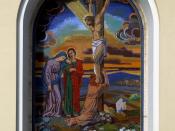This essay will discuss and explore the place of single women in Medieval history. The dawn of marriage, the outcomes for widows and the preference to virginity were all major issues for single women throughout history. The sorts of occupations available to women, from trades people, nuns, farm workers, health advisors, retail in shops and pubs and sex workers were all necessary for sustaining the single women. The leadership of the Catholic Church in communities, and general social moral values in Medieval society also caused the single women grief and trauma.
Marriage was the expected outcome for every good woman in Medieval history. The married state was the only situation where intercourse was thought acceptable. Girls in the upper and middle class families were groomed from birth for a potential match, as the accepted age for marriage was from seven years old. This match was generally the result of desirability on the parents' behalf, which often benefited from social status or in wealth.
The potential marriage would influence the girls' education, treatment and even their place of residence. Often girls were sent away to be raised with a relative or at a monastery. It was also common for girls to be sent to live with the family of the potential groom, and fostered from around the age of two. Such arrangements made the girl a bargaining tool in the deal between families, and girls would often suffer abuse and ill treatment under such situations. Women who were not married by their early twenties were seen as obscure and hopeless (Hanawalt 1977).
Widows were a common identity in the early middle ages due to the death of their husbands from battle or illness. They were often thought of in conflicting representations as pitiable, but also as greedy (Leyser 1997). Whereupon a...


